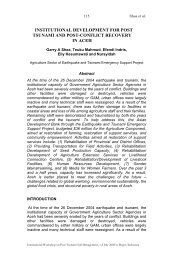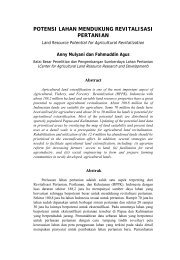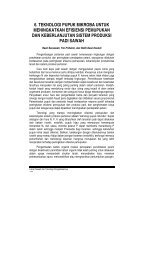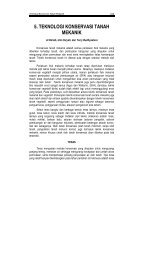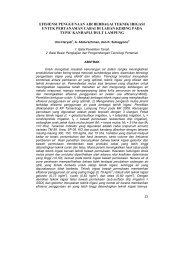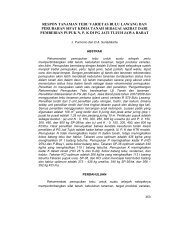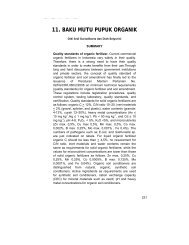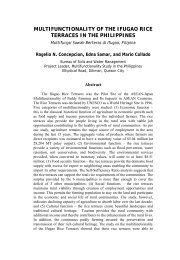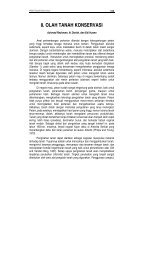Proceedings - Balai Penelitian Tanah
Proceedings - Balai Penelitian Tanah
Proceedings - Balai Penelitian Tanah
You also want an ePaper? Increase the reach of your titles
YUMPU automatically turns print PDFs into web optimized ePapers that Google loves.
120<br />
REHABILITATION/DEVELOPMENT OF SEED PRODUCTION<br />
CAPACITY<br />
Shea et al.<br />
Conflict, earthquakes and the tsunami have severely depleted local<br />
seed production capacity at all levels, including human resources.<br />
Almost all of the seed station facilities and seed production and<br />
processing capacity in Aceh were destroyed in the conflict. The<br />
tsunami also caused loss of seed stock and damaged land where<br />
seeds were produced. As a result, most of the certified seed and<br />
planting stock used during rehabilitation and reconstruction has come<br />
from outside Aceh. To facilitate and sustain reconstruction and<br />
development in the agriculture sector, adequate quantities of certified<br />
seed and planting material (high-quality, locally adapted, and local<br />
accepted materials) are required, and these must reach farmers well<br />
in advance of the planting season. To achieve this, a comprehensive<br />
and integrated strategy/development program has been developed by<br />
the Agriculture Services working together with consultant team for<br />
ETESP. As part of this program, ETESP has provided funding for 4<br />
Provincial Seed Centers (Soybeans, Groundnuts, Horticulture and<br />
Rice). All these centers will be completed in 2008, and brought into<br />
production by the end of the year.<br />
Provincial Seed Center for Horticulture, Saree, Aceh Besar District<br />
The Provincial Seed Center for Horticulture is located in Saree, Aceh<br />
Besar, and covers about 47 ha of farmlands, with another 1000 ha of<br />
government agricultural land lying adjacent to the center. This is a<br />
valuable resource. In addition to the valuable land resource, the site<br />
has established infrastructure including office buildings, warehouses,<br />
screen houses, staff housing, gravity flow water system, and<br />
electricity. The Center lies adjacent to the Saree Agriculture Training<br />
Center which has training classrooms, dormitories/accommodation for<br />
students, staff housing, and land and greenhouses for practical<br />
training. The two centers were damaged and left largely abandoned<br />
during the conflict period, and have now been rehabilitated and<br />
brought back into service.<br />
Provincial Seed Center for Rice, Keumala, Pidie District<br />
Rice is the most important agriculture crop in NAD, and is cultivated<br />
on 367,537 ha of wetland farmlands. An estimated 57,000 of wetland<br />
farmlands (rice fields) were damaged by the tsunami, and are in the<br />
process of rehabilitation. Most slightly and moderately damaged<br />
farmlands are back into production, and overall protection is back to<br />
pre-tsunami levels.<br />
International Workshop on Post Tsunami Soil Management, 1-2 July 2008 in Bogor, Indonesia



